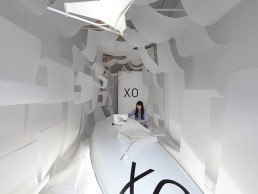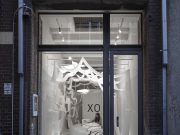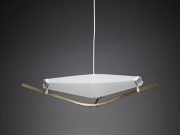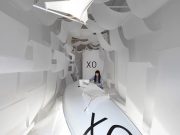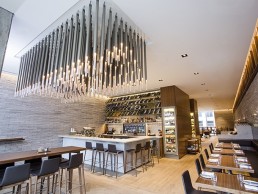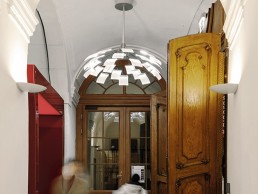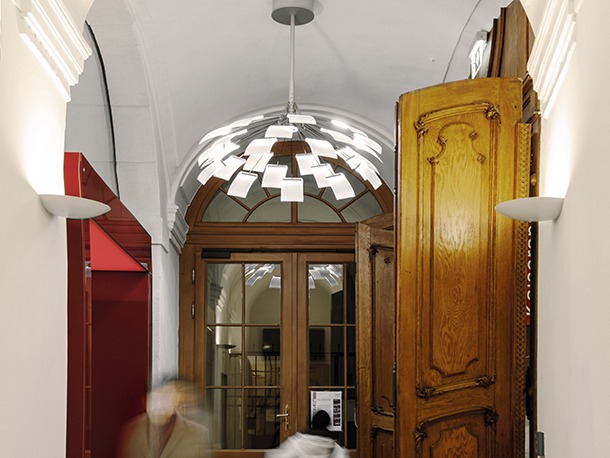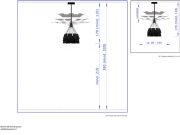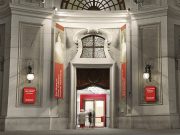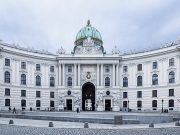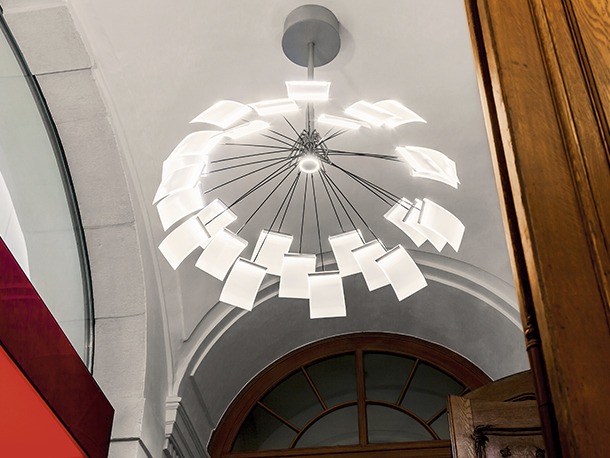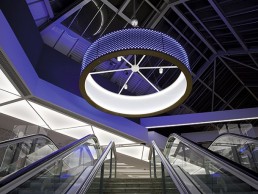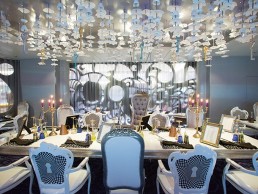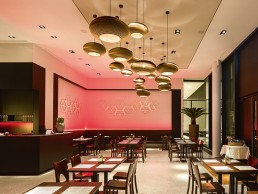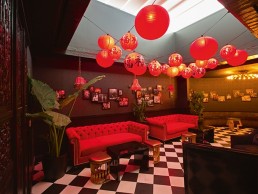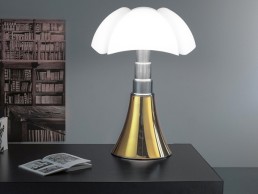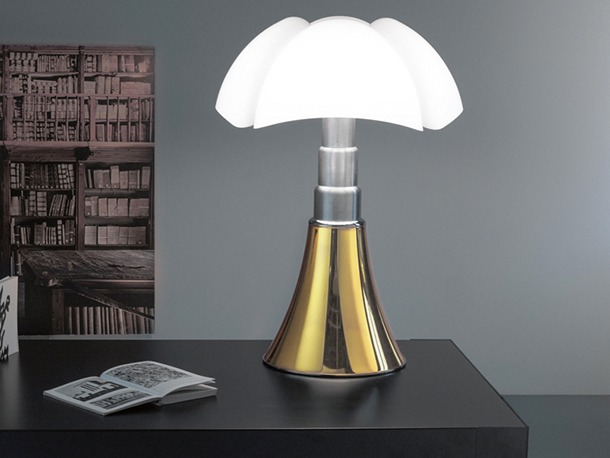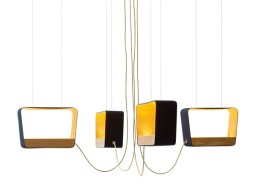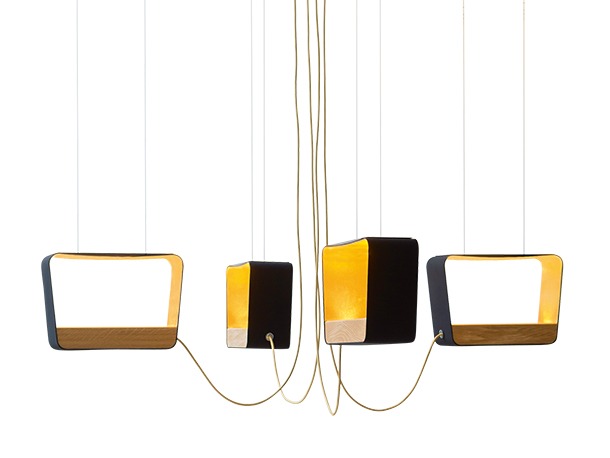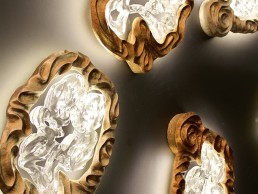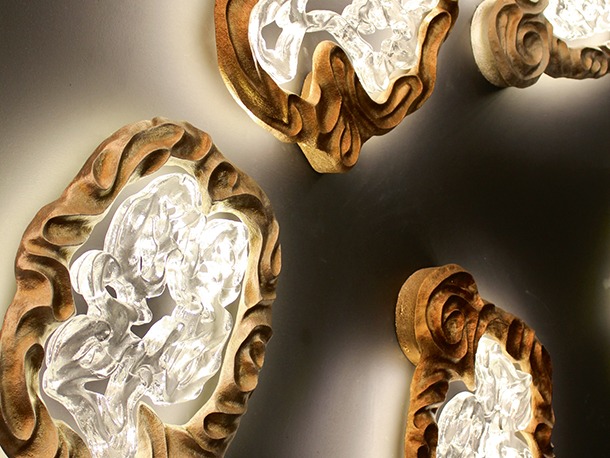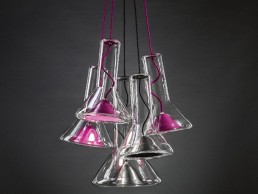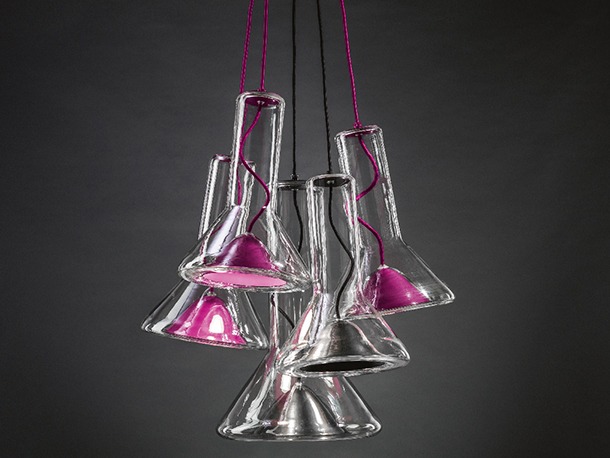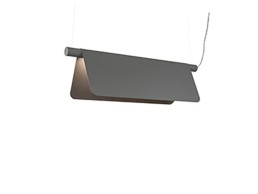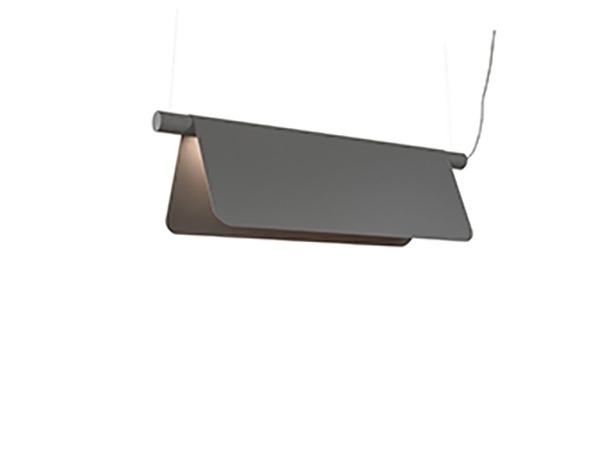Lightloft launch for XO Light
(Australia) Part sail loft, part lighting gallery and store - The lightloft is a temporary space designed to launch the XO light. Designed as an extension of the light, inspired by yacht racing and sail shaping it aims to show how the light is fabricated as well as being inhabited by a sail maker who is fabricating the lights on-site.
XO light is a crafted, hand-made fitting, embodying the elegance of sail shaping and yacht racing. The XO shade is made from two layers of translucent film. Its unique shape is created by an exo-skeleton formed by three aluminium battens attached to the base, available in either matte gold or silver.
Buca Restaurant, Canada
VISO has lit up Costantino Studio's vision of a third Buca restaurant in Toronto, Canada. Honest materials and an elegant touch were used to create authentic Italian style.
A third location of Buca Restaurants is now open at the foot of the Four Seasons in Yorkville, Toronto, Canada. Owned by Peter Tsebelis, Gus Giazitizidis and Rob Gentile of King Street Food Company, this location features a coastal palette of seafood, a special selection of Italian wines, and a contemporary ambience. Buca worked with Costantino Studios who designed the restaurant and co-designed the lighting with VISO. Designed to be the “coastal cousin” of Buca on King Street, the 3,500sqft restaurant was given a lighter feel.
Designer Guido Costantino sought to keep the space simple and elegant with a tie to the food and the origins behind it. “I spent a lot of time with the chef to truly understand the cuisine,” said Costantino. This objective was in part achieved by using honest materials such as marble, white oak and brass. The lighting was integrated seamlessly with the space and the cuisine. Following Costantino’s vision, Filipe Lisboa, head designer at VISO designed, engineered and manufactured the light fixtures.
A large chandelier comprising 220 linear brass tubes that hang from the ceiling - forming a large rectangular shape, was designed by VISO for the entrance in order to create a striking first impression. The lights are long and elegant, of a familiar profile but lighter and more refined - painted with a champagne finish. The brass finished tubes expose light at varying heights from the bottom, while slender metal wire contours each lamp and adds a touch of luxury.
During the engineering stage, the weight of the fixtures posed another challenge. In order to hold the weight of the large chandelier at 2,640lbs, the ceiling needed to be reinforced and Unistrut technology was used to hang the fixture properly and safely from the ceiling. Another objective was to achieve sustainable lighting, and each fixture was designed to accommodate LED lamps. Current LED lamping emits cold light, which is challenging and counterintuitive to a warm environment. However, even with a dimming system the restaurant owners felt the LED lamps did not produce the right luminosity for a restaurant dedicated to Italy and its cuisine. The light needed to feel warm and inviting. For this reason, each lamp was changed to halogen to meet the needs of the design.
An honest and sophisticated approach to the lighting design reflects the elegance of this authentic, Italian eatery.
Imperialist Alley
Denise Hachinger of neonwhite design is the designer behind the LC 1.0 chandelier in which the classic roots of the Hofburg Imperial Palace meet modern influences. Located at the entrance to Sisi Museum, the Imperial Apartments and the Silver Collection, all part of the Hofburg Imperial Palace complex in Vienna, the chandelier appeases the space with each piece unique - from the coating of the light surfaces to the colour of the frame and LED lights.
The chandelier adds space to the Hofburg’s entrance by drawing up light with the spaces between each piece of the chandelier. The translucent medium allows the large chandelier to make a statement without invading the entrance, reflecting off and complementing the light ceiling and arch way.
As the flagship product from neonwhite design’s catalogue, LC 1.0 can transform from a contemporary, yet elegant chandelier into a discrete but efficient uplighting at the touch of a remote control. Handcrafted in Munich, Germany, the chandelier is available in different technical and aesthetic finishes and combines LED lights with award winning design and German technology.
Each element has been individually chosen and varied, with the length of the chandelier also specially adapted to the given ceiling height. With the aim of creating a versatile and transformative light, Hachinger designed LC 1.0 to be opened and closed freely, creating different lighting moods to suit different situations. Using the remote control, the light effect can produce the full spectrum - from focused lighting to full room lighting as required.
Adding to its versality, LC 1.0 is customisable with logos or engravings, coating with crystals or gold lead, through to colour lacquering and anodising, or chandelier pendants. LC 1.0 is both a work of art and a decorative item, using state-of-the-art lighting technology to create the chandelier’s modifiable external shape to diversify its functionality.
Ideal for lobbies, stairways and rooms with high ceilings in hotels, corporate headquarters, or restaurants, the LC 1.0 has been awarded several design prizes in Germany and Austria, including the German Design Award and the Prize of the State Salzburg.
All the features of the chandelier lend themselves naturally to the entrance space of the Hofburg Imperial Palace, shedding light on the history of Vienna, and lighting the way for guests to immerse themselves in the building’s past.
Project Details: Hofburg Imperial Palace, Vienna, Austria
Client: Hofburg Imperial Palace
Lighting Design: Denise Hachinger, neonwhite design
Intu Lakeside, UK
Intu has added another shopping experience to its catalogue of UK-wide centres with Intu Lakeside, a vast shopping complex situated within the largest concentration of retail and leisure in Europe.
The design brief was to increase brightness under deep set soffit areas by day, while allowing the lower level more intimate lighting by night. Lighting Design International took the architects’ start point and the challenges faced, to create a tailor-made final design.
LDI worked closely with acdc on the archtectural lighting to reduce visible light fittings by introducing bright clean linear LEDs concealed in various specialist details. A unique and randomised ceiling soffit feature was created through stacking varying custom-formed indirectly illuminated GRG linear ceiling profiles. During the day this soffit lighting provides indirect lighting and increases apparent brightness to balance against natural light. During the evening the feature dims, allowing glare baffled twin recessed downlighters to provide focused table lighting, saving energy, and reducing the scale of the space for improved ambiance. The seating groups are lit by LED sourced feature pendants from Flos, hung in rows to provide visual interest when viewed from a distance and decorative lighting for charm during evening lighting scenes. Next to these, the fast food retail counters are framed on three sides by evenly back lit panels containing encapsulated organic materials such as twigs and seaweed.
The central atrium area is lit by slimmer, lower level beams with recessed diffused linear lighting. These divide the long space, while providing ambient lighting and decorative feature lines of light, both day and night. Additionally, larger, higher level beams with black-finished integrated slots conceal high output narrow beam adjustable track spotlights, providing pools of light to seating groups during the evening. These are controlled by an astronomical time clock and photocell, to be off during the day, unless light levels from daylight drop too low. All focused downlighting to areas directly adjacent to daylight are commissioned with this logic, to save energy when adequate lighting levels can be provided naturally.
The atrium perimeter ceiling soffit is encompassed by tessellated back-lit triangular stretch ceiling panels. This feature provides a bright even soffit in balance against the day lit skylight, reducing the need for downlighters, dimming by night to provide a dynamic, consistent, highly visible feature ribbon of light to bind the scheme together. The feature ceiling can be experienced from all third floor food court areas, and is also visible from the second floor mall area to attract custom and provide visual interest. Stretch ceiling panels were designed to have triangular form, back lit from the sides only. This helps to increase dynamism, creating a unique feature that reduces lighting flatness. The ceiling panels’ triangular shape helps to visually divide long sections, decrease lighting quantities required and improve maintenance. This detail is a major focal point, and acdc worked closely with LDI to provide the technology that would create the desired lit effect. Mock-ups were created to establish the best possible way of lighting the panels, and it was essential that all the LEDs gave a consistent output and colour temperature across the large installation. Above the escalators, at either end of the food court, four-metre wide by one-metre tall, 400kg pendants add a decorative touch, as light beacons welcome guests to the new food court.
The brief was to create a decorative lighting beacon that could be seen from the second floor mall to announce the redevelopment of the third floor food court. The scale of the third floor atrium automatically determined that the pendants had to be large enough to have the impact desired. Given that the architects had originally envisaged a large shallow empire style shade, it was clear that developing a shade of four-metre diameter was going to be a challenge on many levels. Structurally, fabric would be too unpredictable and would prove to be too low weight, allowing the shade to move or sway like a large sail. A shade this large needed lots of light output, to give it prominence and to achieve consistent illumination. The final colour of the shade was much subject of debate, as the architect had originally proposed red, but such a bold colour in a permanent fixture could prove to be unsuitable in the future, or too overpowering in relation to the rest of the architectural scheme. Maintenance would be a further challenge, with the shade hanging at the top of an escalator in a difficult to access location.
LDI took a visual cue from the already specified Flos Tatou fittings in the fast food area, and began to explore how perforated materials for the external drum could add texture and reduce the visual weight of the fitting. The LDI team wanted the shade to feel internally illuminated, like the original fabric shade concept, but using a much more robust material, and perforated steel sheet was the ideal solution. Using the perforated sheet for the external lighting allowed the build up of layers of light, with the internal lighting being provided by a separate linear LED light source, and also allowing the shopping centre to use the shades internal face for possible future graphics application.
As the shade concept developed, LDI identified that it had three clear functions, requiring three types of lighting, each with its own individual control. The shade had to provide feature lighting to its exterior that could be seen from a distance, and it was determined that this lighting would be RGBW, allowing the shade to change its colour and personality from day to night, seasonally or over the life time of the shopping centres requirements. The shade had to provide a warm white inviting ambient lighting effect to the top of the escalator and when viewed from below, to soften the view of the glass roof and sky during the late evening and night, this effect was provided by 3,000K linear halo lighting to the internal surfaces of the shade. Finally the shade had to offer high output directional lighting to the top of the stairs to provide adequate light levels for safety. This was achieved via 2,220lm lockable adjustable spotlights.
Soon after the shade’s functions, general aesthetics and scale had been defined by LDI, Mike Stoane Lighting was approached to assist with the shade’s technical design. Mike Stoane Lighting was sure that the shade had to be fully constructed from steel for structural strength and it was agreed that a full scale 1/6 shade mock-up would be produced to test lighting effects and to confirm aesthetics and structural design. With Mike Stoane Lighting’s assistance the shade was developed to have a clutch mechanism at the mounting location, allowing the shade to be rotated to maintain any section from a safe location back away from the top of the staircase. LDI used variations of Mike Stoane Lighting standard luminaires to provide the lighting effect to the large custom built shade, with 2220lm Podgy fittings providing the directional downlight, 1960lm/m G2 high output strip providing the warm white ambient lighting and a similar Mike Stone Lighting RGB LED profile providing the colour variable external lighting.
The final shade incorporates six channels of DALI control for internal white lighting, external white lighting, external RGB lighting and high power spotlighting, and the shade weighs in excess of 300kg.
Through considerable design and architectural challenges, the Intu Lakeside food hall has arisen as a well-thought-out space with intelligent lighting decisions.
www.lightingdesigninternational.com
Project Details: Intu Lakeside Food Hall, Essex, UK
Client: Intu
Interior Design: rawls
Lighting Design: Lighting Design International
Lighting Suppliers: Mike Stoane Lighting, Flos, acdc,
Tom Dixon (using Megaman LED Opal Classic Dimming lamp)
Wonderland Restaurant, Caribbean
A new technology cruise ship has landed in the Caribbean Sea: Quantum of the Sea of the Royal Carribean. Pushing the boundaries of technology and innovation, the new Quantum Class ships showcase advanced technology; from a 300ft high viewing capsule, North Star, to a skydiving simulator.
One of the eighteen restaurants aboard, the Wonderland, carries within it a bespoke lighting feature. In this area, that seats only 62 guests, an exclusive culinary experience has been lit by a magnificent chandelier from La Murrina.
Technological development, attention to detail and passion are the characteristics of this unique environment that offers a journey into the world of the imagination of Wonderland.
The chandelier, which was designed to enhance the experience on board, has meticulous dimensions (2,204mm x 4,262mm) and consists of approximately 500 fibreglass elements of different shapes: flower open, corolla bell-shaped, heart and key.
Decorative elements are fastened to steel rods of various lengths, some of which are lit by a fibre optic system. Two projectors emanate light of different colours to create the effect of a starry sky, while a third projector illuminates the elements of the composition.
The system is controlled via Digital MultipleX offering to passengers spectacular games of light. Wonderland was a challenge won by La Murrina and its team of engineers. It was the first project of its kind made at the company’s headquarters in Turate, Italy.
The lighting concept was developed around the tale of Lewis Carroll’s Alice in Wonderland. The idea was to tell a story starting with the interior design, colour, scale and reflection to infuse elements of surprise and delight throughout the entire dining experience. Wonderland intends to bend the realities of what a restaurant is. The magnificent chandelier offers a journey into the imagination.
LWL Museum, Germany
After a perennial construction period the LWL Museum for Art and Culture in Munster was re-opened in September 2014. Now housing a library, auditorium, bookshop and restaurant, the carefully constructed lighting concept by Licht Kunst Licht offers flexible exhibition illumination for both daytime and evening settings.
The lighting concept for the restaurant was developed in close coordination with the architects and the restaurant’s tenant, aiming to offer two distinct luminous qualities. Decorative pendant luminaires along the patio façade from Filumen and from Graypants in the refractory facing the Rothenburg Square, generate a friendly and bright light atmosphere for the daytime use as a café.
In the evening hours, the light is transformed in order to create a more introverted, romantic spatial ambience, as the pendant luminaire can be strongly dimmed in order to fade into the background. At the same time, Flos’ adjustable downlights act to direct punctual light on the tables. As an additional third light source, LED Linear’s light strips executed in RGB are integrated underneath the benches and bar furniture producing a soft vertical illumination on the walls.
Between the various suppliers involved and Licht Kunst Licht’s concept, the restaurant space glides seamlessly through the day providing ambient lighting in morning and evening for the LWL Museum visitors to relax and reflect on their immersion in German art and culture.
Pics: Marcus Ebener
Project Details: LWL Museum for Art and Culture, Munster, Germany
Client: LWL Museum for Art and Culture
Lighting Design: Licht Kunst Licht
Lighting Suppliers: Flos, Graypants, LED Linear, Filumen
Blind Dragon, US
Blind Dragon is the latest lounge concept from H.Wood Group (Henry’s, Bootsy Bellows, The Nice Guy). A bar with an excess of Hollywood glamour and cool, this new ‘it’ bar brings karaoke back into fashion.
President and founder of design / build company Built Inc. and New York native, John Sofio, approached this project with a particular process in mind. Sofio first got a feel for the space and its energy, then moved on to sketch ideas for design solutions. First, creating the floorplan and circulation, layering the interior elevations and surfaces, followed by colours and finishes. For Sofio, it is only after knowing where the walls will be located, and where the critical areas of space will be (entry, bar, seating, booths, walls) that the lighting design “happens”.
Darkness is used at Blind Dragon to sculpt light by bouncing it off of horizontal and vertical surfaces and reflected onto areas Sofio wanted to light. Inspired by 1940’s Shanghai, Sofio designs with a keen eye on the user’s experience. “I want to make them feel like they are home, comfortable, invited and wanted,” he said.
Each room has been designed to transport guests into another place and time; created to free them of inhibition and encourage performance in front of friends.
The house DJ Wade Crescent, who programs the nights at Blind Dragon has a soft spot for leopard print, pineapples, black and white checkered floors and red and black decor. These elements were touched upon with a crystal pineapple DJ booth (including a brass pineapple lamp), black and white floor in the main Blind Dragon room and black and red has been used in the main lounge for the furniture and wall stains.
The goal of the project was to comfort guests through lighting, creating a space where they want to spend their entire night. This was achieved through a number of lighting design choices. Dim lighting was a necessity for creating a comfortable, warm experience, with layers of multiple localised light sources. Outside each karaoke room a red industrial cage light has been chosen to signal the wait staff from inside the room, minimising the interaction with the guests to allow a more private and intimate experience.
Above: A bespoke ceiling feature graces a den-like space in the main lounge and the Blind Dragon room oozes a dark East Asian aesthic, with a red theme running from the furniture to Chinese lanterns covering the ceiling.
Amongst the interior of the bar, hidden LED strips in the columns, and along the edge of the VIP deck, highlight surfaces with indirect light.
Lanterns feature throughout the ceiling making use of LED lamps covered in frosted gels to disperse light. These lanterns can also be found above the karaoke rooms and are seen from the main lounge. Lighting in the karaoke rooms is kept minimal to allow for a dark and sexy vibe - just two pin spots - one on the singer and one bouncing off the walls, these are controlled by a Lutron dimming system (as is all the lighting at the venue).
Small vintage lamp shade pendants in the various seating areas create intimate moments within the larger space, while simple string lights of Chinese lanterns create a cloud of fixtures above the main room. An amber colour palette was employed throughout to create a sultry, exotic feel.
Lighting World in Van Nuys, LA provided all the vintage shades and the components were built by Built Inc. themselves.
Above: A brass pineapple lamp decorates the DJ booth, vintage lamp shade pendants add intimacy to seating areas and strings of chinese lanterns engulf the Blind Dragon room (main room) in sultry red light.
Pics: Elizabeth Daniels
Pipistrello
Pipistrello is a table lamp providing diffused light. The height can be adjusted by the telescopic element in satin-finish stainless steel. The shade is made of opal white methacrylate. Base and knob in painted metal are available in white, dark brown, purple-red and shiny black, made of satin-finish aluminium or shiny copper. The lamp uses energy-saving fluorescent bulbs or LEDs.
luster Eau de Lumière
The design, by Davide Oppizzi, is focused on the masculine and feminine forms, with curves and angles, matched together using noble materials such as wood, marble and fabrics. The shapes, materials and colours allow a homogeneous but varied spirit and a strong personality. Within the family products, the collection offers several shapes and sizes.
Collections
Serip collections are inspired by nature to create unique lighting fixtures, endless colours, shapes and sizes to suit the needs of every home or project. Serip’s passion for lighting and search for innovation in design demonstrates a unique point of view, with each piece designed as a light sculpture, created and produced manually.
Whistle
The external shape of Whistle symbolises the shape of traditional whistles as the inserted spot lamp is highlighted by offset inks. The outer form creates an impression of a shade for the pendant and further defines the precise shape of the elongated pipes. Whistle lamp collection consists of three glass pipes of larger dimensions: 300mm x 400mm, 380mm x 550mm, 450mm x 700mm.
Bend
The base consists of either painted aluminum or a combination of flocked aluminum and painted wood, with LED light sources throughout the models. The depth of the shade creates an even and glare free light while reflecting the light inside the fitting. Details can be flocked / painted in other colours and manufactured in other sizes by request.


